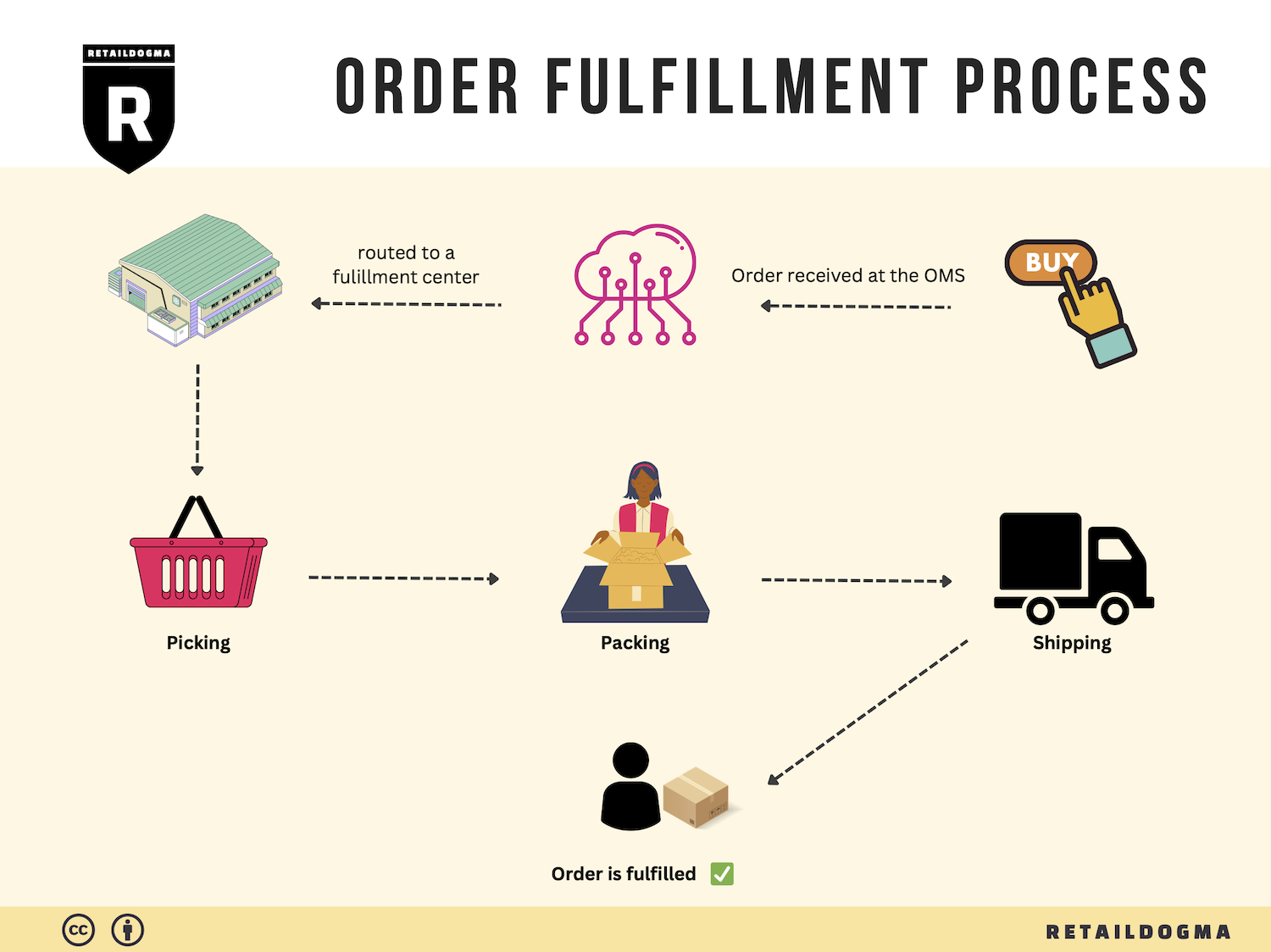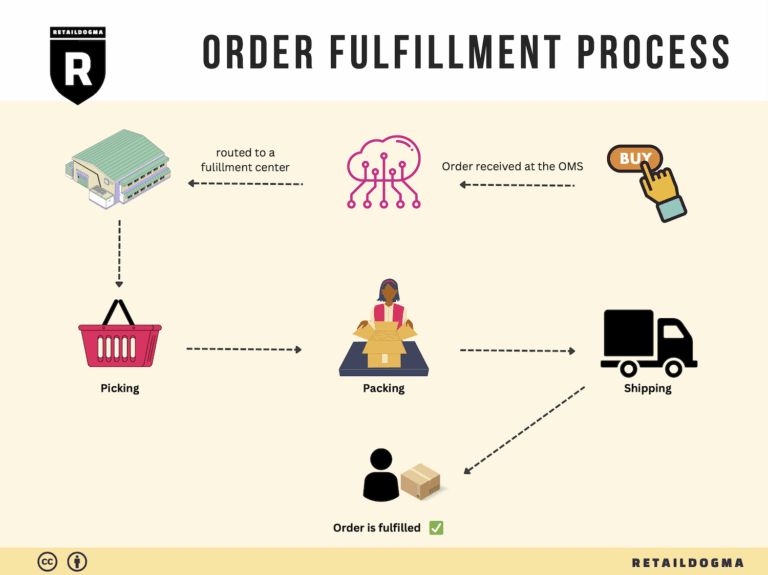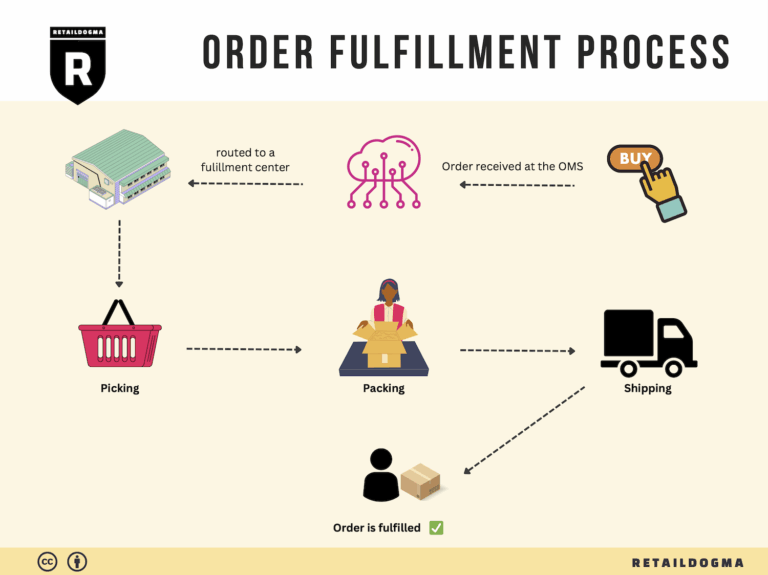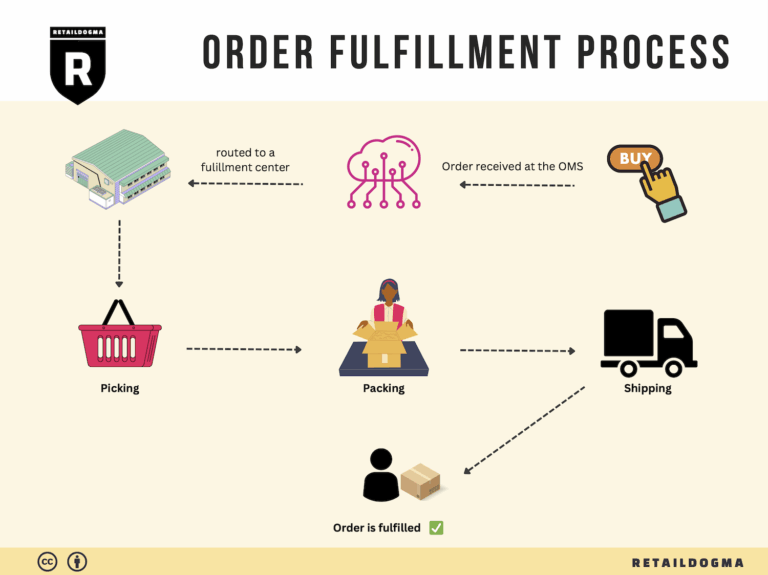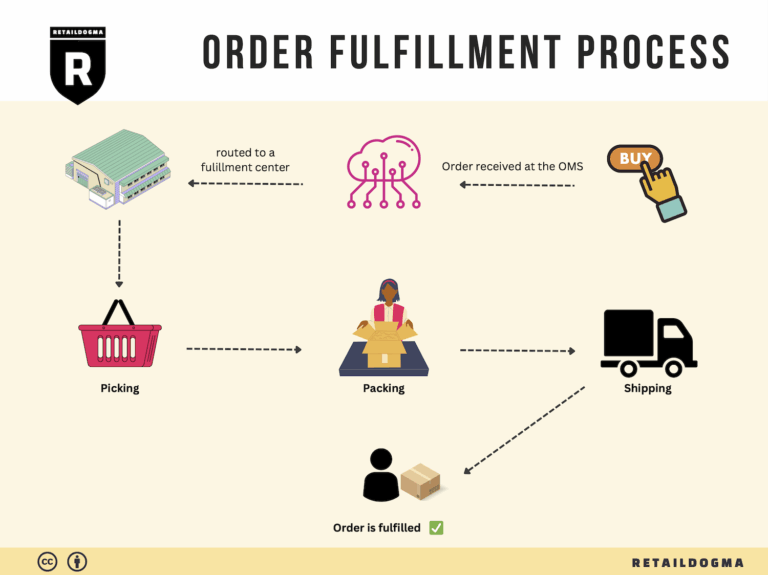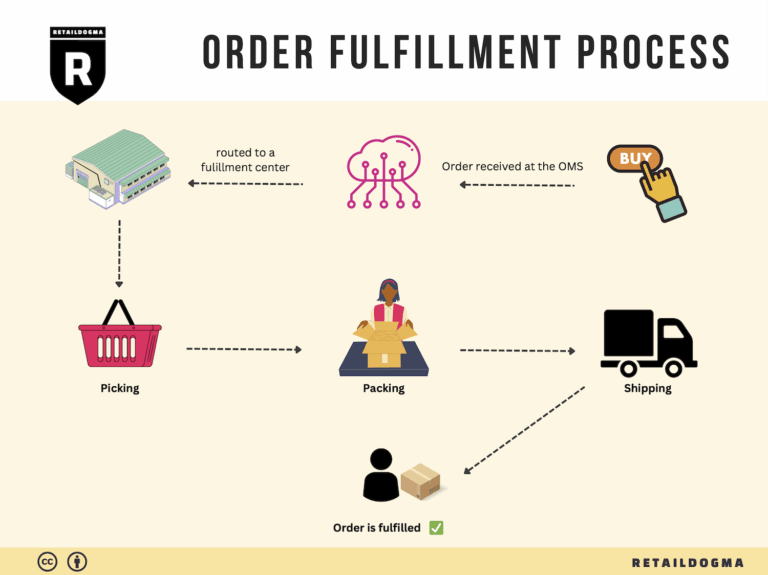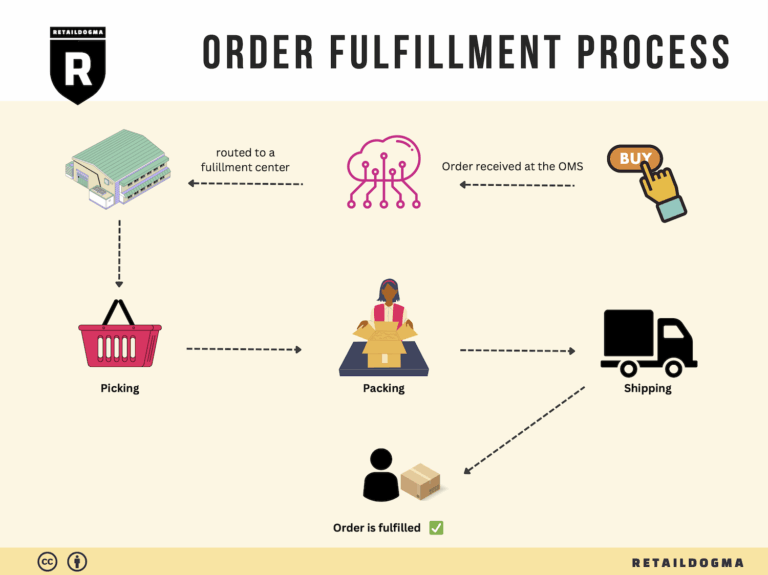What Is A Fulfillment Center? A Complete Guide (2025)
What is E-commerce Fulfillment? An Introduction for Growing Businesses
Understanding E-commerce Fulfillment
As an e-commerce business owner, you’ve likely experienced the growing pains of managing orders, packing products, and shipping them out on time. The process can quickly become overwhelming, especially as your sales increase and customer expectations rise. The last thing you want is to let logistical challenges hinder your business’s growth. This is where e-commerce fulfillment comes into play.
At its core, fulfillment is the process of getting a product into the hands of your customers. It encompasses everything from receiving inventory and storing it, to picking, packing, and shipping orders. Efficient fulfillment is crucial for maintaining customer satisfaction and loyalty, which are essential for scaling your business. However, navigating the complexities of fulfillment can be daunting, especially when you’re trying to focus on other aspects of your business.
In this guide, we will explore the various models of e-commerce fulfillment available to growing businesses. We’ll delve into options like Third-Party Logistics (3PL) and Fulfillment by Amazon (FBA), examining the pros and cons of each. Understanding these models will help you determine which aligns best with your business needs and growth trajectory.
We will also cover the core services that fulfillment partners typically offer, including inventory management, order processing, and shipping logistics. These services can significantly reduce your operational workload, allowing you to focus more on strategic initiatives rather than day-to-day tasks.
Choosing the right fulfillment partner is a critical decision that can impact your customer experience and overall business efficiency. This guide will provide you with practical criteria for selecting a partner that meets your specific requirements, ensuring a seamless integration into your existing operations.
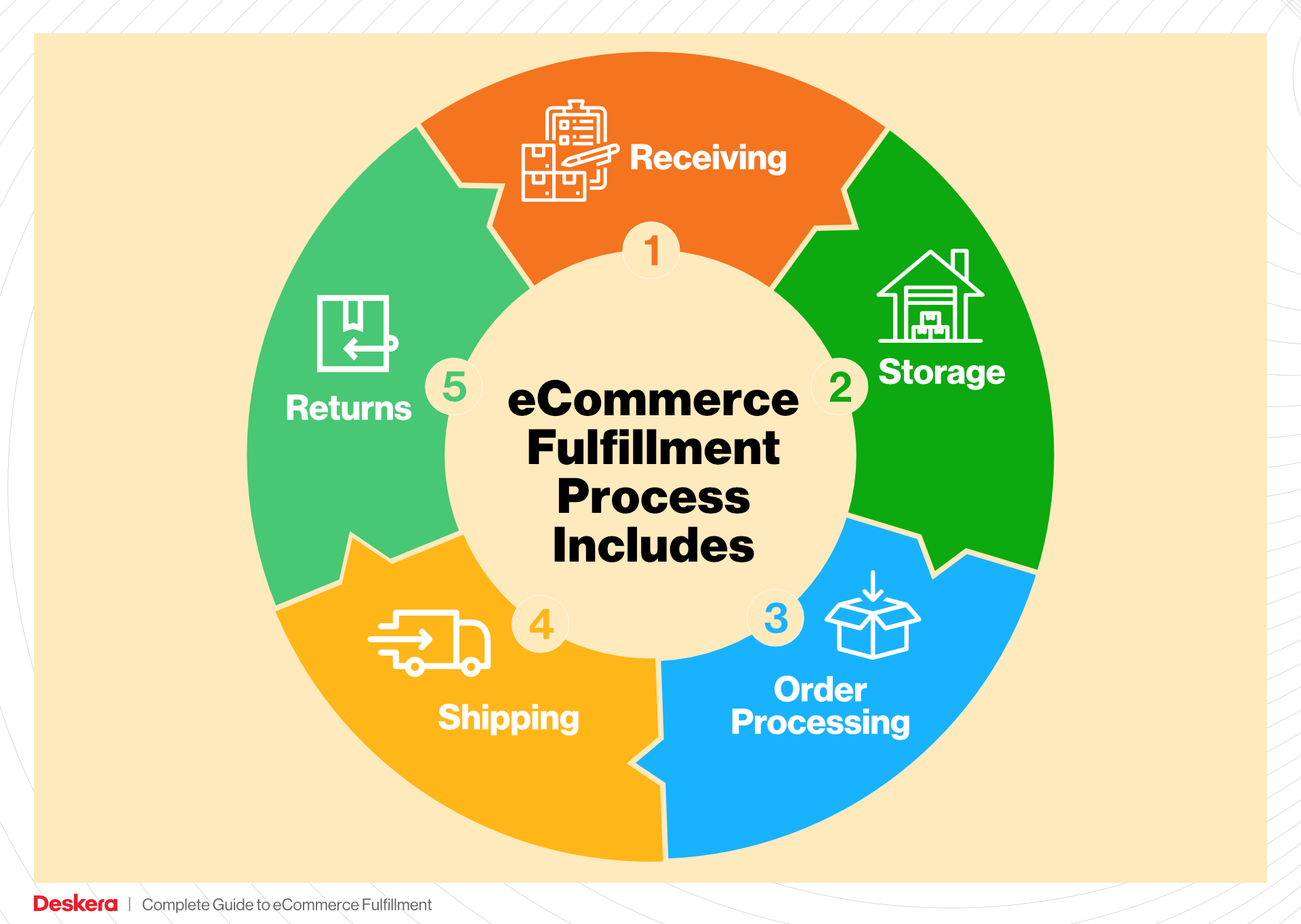
Additionally, we’ll discuss pricing structures associated with various fulfillment services, helping you to understand the costs involved and how they can affect your bottom line. Having a clear picture of pricing will empower you to make informed decisions that align with your budget and growth objectives.
Ultimately, this guide aims to empower you to make smart, strategic decisions about your logistics and fulfillment processes. By understanding your options and the intricacies of fulfillment, you can streamline your operations, enhance customer satisfaction, and set the stage for sustainable growth in your e-commerce business.
What You’ll Learn In This Guide
- What is E-commerce Fulfillment? An Introduction for Growing Businesses
- The Order Fulfillment Process: From ‘Buy’ Button to Customer’s Door
- Comparing Fulfillment Models: In-House vs. 3PL vs. Dropshipping
- A Deep Dive into Amazon FBA: Pros, Cons, and Who It’s For
- Core Services Offered by Fulfillment Centers
- How to Choose a Fulfillment Partner: A 6-Point Checklist
- Understanding Fulfillment Pricing: A Breakdown of Common Fees
- Frequently Asked Questions (FAQs) about Fulfillment
- Conclusion: Is Outsourcing Fulfillment the Right Move for Your Business?
- Important Disclaimer
The Order Fulfillment Process: From ‘Buy’ Button to Customer’s Door
1. Receiving Inventory
The order fulfillment process begins with receiving inventory from suppliers or manufacturers. This step is crucial as it sets the foundation for your entire supply chain. Upon arrival, products must be checked against purchase orders to ensure accuracy in quantity and quality. This involves inspecting for damages and verifying that the correct items have been received.
Key Term: SKU (Stock Keeping Unit)
Each product should be assigned a unique SKU, which aids in tracking inventory levels and organizing products efficiently. Proper receiving practices help maintain accurate inventory records, which are vital for managing stock levels and preventing stockouts or overstock situations.
2. Warehouse Storage
Once the inventory is received and verified, it must be stored in a designated area within the warehouse. Effective warehouse storage is essential for optimizing space and ensuring easy access to products when orders are placed. Products should be organized based on factors such as size, weight, and demand frequency, utilizing systems like FIFO (First In, First Out) or LIFO (Last In, First Out) as appropriate.
Key Term: Location Code
Implementing a location code system helps in categorizing and easily locating items within the warehouse. This improves operational efficiency and reduces time spent searching for products, ultimately speeding up the order fulfillment process.
3. Order Picking
When a customer places an order, the next step is order picking, where the necessary items are selected from storage. This process can be done manually or through automated systems, depending on the size and scale of the operation. Efficient order picking is vital as it directly impacts order accuracy and speed.
Key Term: Pick List
A pick list is generated, detailing the items needed for each order, including their locations in the warehouse. Utilizing pick lists helps streamline the picking process and ensures that the correct items are retrieved, reducing the chances of errors and returns.
4. Order Packing
Once items are picked, they are moved to the packing station, where the order is prepared for shipment. This step includes assembling the items, applying protective packaging, and labeling the package for delivery. Proper packing is essential to prevent damage during transit and to ensure compliance with shipping regulations.
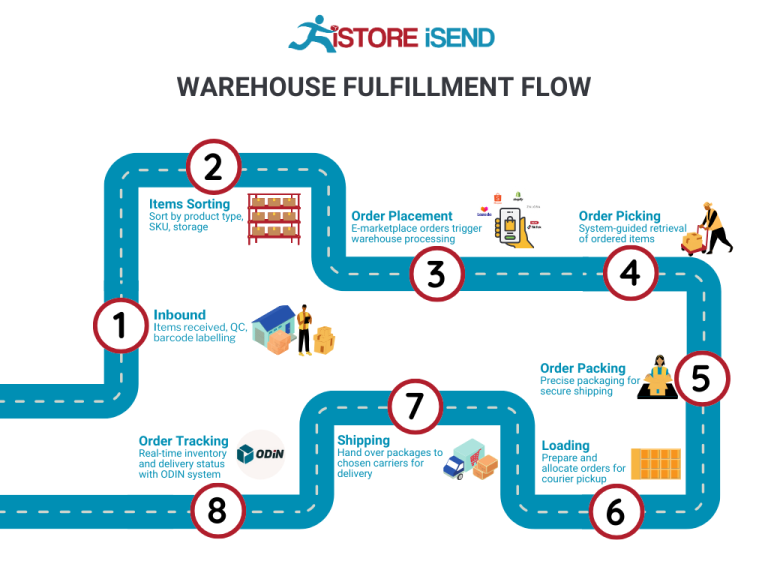
Key Term: Packing Slip
A packing slip is included with the order, detailing the items packed and serving as a receipt for the customer. This not only enhances customer satisfaction by providing transparency but also helps in inventory management by keeping records of what has been shipped.
5. Shipping & Delivery
The final step in the order fulfillment process is shipping and delivery. Once packed, the orders are scheduled for shipment using the chosen carrier. This stage involves selecting the most cost-effective and timely shipping options to meet customer expectations. Efficient shipping and delivery are crucial for customer satisfaction and can significantly impact repeat business.
Key Term: Tracking Number
A tracking number is generated for each shipment, allowing customers to monitor their order’s progress. Providing tracking information enhances the customer experience by keeping them informed and reducing inquiries about order status, ultimately leading to higher satisfaction and trust in your brand.
By understanding and optimizing each of these five steps in the order fulfillment process, e-commerce businesses can improve operational efficiency, enhance customer satisfaction, and scale their operations effectively.
Comparing Fulfillment Models: In-House vs. 3PL vs. Dropshipping
Fulfillment Model Comparison
| Model | Who Handles Inventory | Best For (Business Stage) | Key Advantage | Key Disadvantage |
|---|---|---|---|---|
| In-House Fulfillment | The Business Itself | Established businesses with stable sales | Complete control over inventory and fulfillment processes | High overhead costs and resource-intensive |
| Third-Party Logistics (3PL) | Third-Party Providers | Growing businesses seeking scalability | Flexibility and access to expert logistics services | Less control over inventory and potential communication issues |
| Dropshipping | Supplier or Manufacturer | Startups and small businesses with limited capital | Low upfront investment and reduced inventory risk | Lower profit margins and reliance on supplier reliability |
In-House Fulfillment
In-house fulfillment involves managing all aspects of the logistics process within your own business. This model is often favored by established companies that have the necessary resources, space, and workforce to handle inventory management, packing, and shipping. The primary advantage of in-house fulfillment is the level of control it affords; businesses can oversee every aspect of the fulfillment process, ensuring quality and timeliness. Additionally, having direct access to inventory allows for quick adjustments to orders and a personalized customer experience. However, this model also comes with significant disadvantages, including high overhead costs related to warehousing, staffing, and technology. Businesses need to invest heavily in infrastructure and may struggle with scalability during peak seasons or unexpected demand spikes.
Third-Party Logistics (3PL)
Third-party logistics (3PL) providers offer a comprehensive solution for businesses looking to outsource their fulfillment operations. These companies specialize in logistics services, including warehousing, inventory management, order processing, and shipping. 3PL is particularly beneficial for growing businesses that require flexibility and expertise without the overhead of managing logistics in-house. By leveraging a 3PL, businesses can scale operations more easily, tap into advanced logistics technology, and gain access to a network of distribution channels. However, outsourcing fulfillment can lead to a loss of control over inventory management and fulfillment processes. Communication challenges may arise if there are discrepancies in inventory levels or order accuracy, potentially impacting customer satisfaction. Therefore, it’s essential to choose a reputable 3PL partner with strong communication and technology integration capabilities.
Dropshipping
Dropshipping is a fulfillment model where the retailer does not keep products in stock. Instead, when a customer makes a purchase, the retailer purchases the item from a third-party supplier who then ships it directly to the customer. This model is ideal for startups and small businesses with limited capital since it requires minimal upfront investment in inventory. The primary advantage of dropshipping is the reduced financial risk, as businesses only pay for products after they have been sold. Additionally, it allows for a wide product range without the burden of inventory management. However, dropshipping can lead to lower profit margins due to reliance on suppliers, who may offer competitive pricing. Businesses also face challenges with fulfillment speed and quality control, as they depend on the supplier’s performance. This reliance can lead to customer dissatisfaction if there are delays or issues with the products. Therefore, thorough vetting of suppliers is critical for success in this model.
Conclusion
Choosing the right fulfillment model is crucial for the scalability and success of your e-commerce business. Each model—In-House Fulfillment, Third-Party Logistics, and Dropshipping—has its unique advantages and disadvantages that must align with your business goals, resources, and customer expectations. Understanding these models in-depth will empower you to make informed decisions that support your growth strategy while minimizing risks and maximizing customer satisfaction.
A Deep Dive into Amazon FBA: Pros, Cons, and Who It’s For
Understanding Fulfillment by Amazon (FBA)
Fulfillment by Amazon (FBA) is a service offered by Amazon that allows sellers to store their products in Amazon’s fulfillment centers. Amazon takes care of storage, packaging, and shipping of these products to customers. In addition to the logistics, FBA also provides customer service and handles returns on behalf of sellers. This service can significantly simplify the selling process for e-commerce businesses, enabling them to focus on other aspects of their operations, such as marketing and product development.
How FBA Works
-
Product Listing: Sellers create product listings on Amazon and enroll in FBA. They can choose to fulfill existing listings or create new ones specifically for FBA.
-
Shipping Inventory: Sellers ship their products to Amazon’s fulfillment centers. Amazon provides guidance on which fulfillment center to send products to based on their locations.
-
Storage: Once the products arrive, they are stored in Amazon’s warehouses. Sellers are charged storage fees based on the amount of space their inventory occupies.
-
Order Fulfillment: When a customer places an order, Amazon takes care of the entire fulfillment process. This includes picking, packing, and shipping the product directly to the customer.
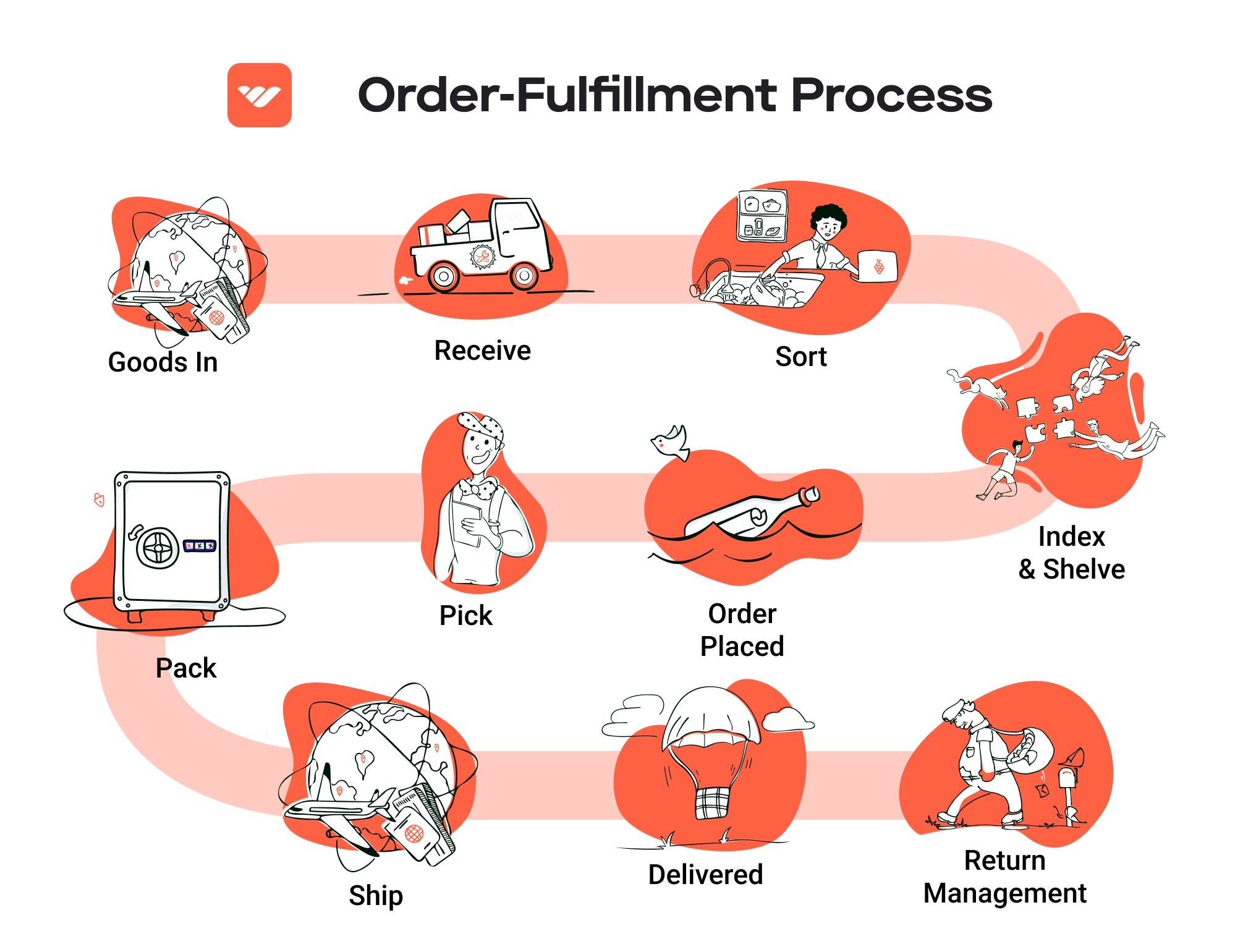
-
Customer Service: Amazon also handles customer inquiries and returns, providing sellers with a seamless experience.
-
Prime Eligibility: Products fulfilled by Amazon are eligible for Amazon Prime, which can increase visibility and sales due to the appeal of fast, free shipping.
Pros of Using FBA
-
Prime Eligibility: One of the standout features of FBA is that products become eligible for Amazon Prime. This can significantly enhance sales, as millions of Prime members tend to prefer products that offer fast and free shipping.
-
Increased Customer Trust: When products are fulfilled by Amazon, customers often feel more secure in their purchases. Amazon’s reputation for customer service and efficient delivery can lead to higher conversion rates for sellers.
-
Multi-Channel Fulfillment: FBA allows sellers to fulfill orders from multiple sales channels, including their own websites and other marketplaces. This flexibility can streamline operations and enhance customer service.
-
Time-Saving: By outsourcing logistics to Amazon, sellers can focus on other critical aspects of their business, such as product development and marketing.
-
Scalability: FBA provides the infrastructure needed to scale operations without the need for significant investment in logistics and warehousing.
Cons of Using FBA
-
High Fees: While FBA offers many advantages, sellers must be mindful of the costs involved. Amazon charges various fees, including storage fees, fulfillment fees, and additional charges for long-term storage of products. These fees can add up and eat into profit margins, especially for low-cost items.
-
Strict Inventory Rules: Amazon has strict policies regarding inventory management, including limitations on how much inventory can be sent and how long it can be stored. Sellers must be diligent in managing their stock levels to avoid extra fees or stockouts.
-
Commingling Risks: FBA products may be commingled with other sellers’ inventory in Amazon’s warehouses. This can pose risks, such as receiving returns of different products or counterfeit items. Sellers must weigh this risk against the convenience of using FBA.
-
Loss of Control: By using FBA, sellers relinquish some control over the fulfillment process. Issues such as shipping delays or inventory errors can reflect poorly on the seller, even if they are the result of Amazon’s operations.
-
Complex Returns: While Amazon handles returns, the process can be complicated for sellers, especially if they receive products back that are damaged or not in resalable condition.
Who is FBA Best For?
FBA is particularly well-suited for small to medium-sized e-commerce businesses that want to scale quickly without investing heavily in logistics infrastructure. It is ideal for:
-
New Sellers: Entrepreneurs who are just starting and may not have the resources to manage fulfillment can benefit greatly from FBA’s all-in-one service.
-
Sellers with High Sales Volume: Businesses that anticipate selling large volumes of products will find FBA advantageous due to its efficiency in handling logistics.
-
Brands Seeking Visibility: Companies looking to enhance their visibility on Amazon and attract more customers will benefit from the Prime eligibility that comes with FBA.
-
Retailers Focused on Growth: Those aiming to expand their business across multiple channels while minimizing logistical burdens will find FBA to be a valuable partner.
In conclusion, while Fulfillment by Amazon offers significant advantages in terms of logistics, customer trust, and scalability, businesses must carefully consider the associated costs and risks. By understanding both the pros and cons of FBA, e-commerce business owners can make informed decisions that align with their growth strategies and operational capabilities.
Core Services Offered by Fulfillment Centers
Inventory Management & Warehousing
Inventory management and warehousing are foundational services provided by fulfillment centers, essential for any e-commerce business looking to scale efficiently. This service involves the systematic control of stock levels, ensuring that products are available when needed while minimizing excess inventory.
Fulfillment centers utilize advanced inventory management systems that track stock in real-time, providing businesses with accurate data on inventory levels, product turnover, and storage availability. This capability allows businesses to make informed decisions about reordering, seasonal stock adjustments, and overall inventory strategy.
Benefits:
1. Reduced Costs: By optimizing inventory levels, businesses can reduce costs associated with overstocking and storage fees.
2. Improved Cash Flow: Efficient inventory management ensures that capital is not tied up in excess inventory, allowing businesses to invest in growth opportunities.
3. Enhanced Customer Satisfaction: Real-time inventory tracking means customers receive accurate information about product availability, leading to improved trust and customer satisfaction.
Pick and Pack Services
Pick and pack services are critical to the order fulfillment process. This service involves selecting the ordered items from the warehouse (picking) and then packing them securely for shipment (packing). Fulfillment centers employ trained staff and sophisticated technology to streamline this process, ensuring accuracy and efficiency.
The picking process typically involves scanning items to ensure the correct products are selected, while packing ensures that items are shipped safely and cost-effectively. This may include using appropriate packaging materials and methods to minimize damage during transit.
Benefits:
1. Efficiency and Speed: Automated systems and trained personnel can significantly reduce the time taken to fulfill orders, allowing businesses to meet customer expectations for fast shipping.
2. Error Reduction: The use of technology, such as barcode scanning, minimizes errors in order fulfillment, leading to fewer returns and improved customer satisfaction.
3. Scalability: As order volumes grow, fulfillment centers can easily scale up their pick and pack operations, enabling businesses to handle increased demand without compromising service quality.
Kitting and Assembly
Kitting and assembly services are specialized offerings that involve grouping individual items into ready-to-ship sets or assembling products before shipping. This service is particularly beneficial for e-commerce businesses that sell products requiring assembly or those that offer bundled products.
Fulfillment centers can customize kitting processes based on business needs, ensuring that all components are included and properly assembled. This can include anything from assembling furniture to creating gift baskets or promotional kits.
Benefits:
1. Streamlined Operations: By outsourcing kitting and assembly, businesses can focus on their core activities, such as marketing and customer service, while the fulfillment center handles complex packaging tasks.
2. Enhanced Customer Experience: Delivering pre-assembled kits or bundles can improve customer satisfaction, as it reduces the effort required from the customer’s side and enhances the perceived value of the product.
3. Cost-Effectiveness: Outsourcing these services can be more cost-effective than handling them in-house, particularly for businesses with fluctuating demand or those launching new products.
Returns Management (Reverse Logistics)
Returns management, or reverse logistics, is a vital service for e-commerce businesses, enabling them to handle product returns efficiently and effectively. This service encompasses the entire process of managing returned goods, from receiving and inspecting returned items to restocking or disposing of them as necessary.
Fulfillment centers implement streamlined processes for returns, including automated tracking systems that provide businesses with insights into return reasons and patterns. This data can inform product quality improvements and customer service strategies.
Benefits:
1. Improved Customer Retention: Efficient returns processing enhances the customer experience, leading to higher satisfaction and increased likelihood of repeat purchases.
2. Cost Savings: By managing returns effectively, businesses can minimize losses associated with returned inventory and reduce operational costs related to processing returns in-house.
3. Data-Driven Insights: Analyzing return data helps businesses understand customer behavior and product issues, allowing them to make informed decisions about inventory and product offerings.
In conclusion, utilizing fulfillment centers for these core services can significantly enhance the operational efficiency of e-commerce businesses. By leveraging expert inventory management, streamlined pick and pack services, kitting and assembly, and effective returns management, businesses can not only scale their logistics operations but also improve overall customer satisfaction and retention.
How to Choose a Fulfillment Partner: A 6-Point Checklist
Location & Warehouse Network
Importance: The location of your fulfillment partner’s warehouses is critical for ensuring timely delivery to your customers. A strategically positioned warehouse network can significantly reduce shipping times and costs, which is vital for customer satisfaction and retention.
Questions to Ask:
– Where are your warehouses located, and how do they align with my target customer demographics?
– Do you have warehouses in multiple regions to facilitate quicker shipping?
– What are your average shipping times to key markets?
Technology & Integrations
Importance: In today’s fast-paced e-commerce environment, a fulfillment partner should offer robust technology solutions that integrate seamlessly with your existing systems. This will enable real-time inventory tracking, order management, and data analytics, streamlining operations and enhancing customer experience.
Questions to Ask:
– What technology platforms do you use for order processing and inventory management?
– Can your system integrate with my e-commerce platform (e.g., Shopify, WooCommerce, Magento)?
– Do you provide real-time tracking for orders, and how can I access this information?
Specializations (e.g., Cold Storage, Oversized Items)
Importance: Depending on the nature of your products, you may require a fulfillment partner with specific capabilities. For instance, if you sell perishable goods, a partner with cold storage facilities is essential. Similarly, if your products are large or bulky, ensure the partner has the infrastructure to handle oversized items.
Questions to Ask:
– What types of products do you specialize in fulfilling?
– Do you have specific facilities for temperature-sensitive items?
– How do you handle unique storage requirements for oversized or fragile items?
Scalability & Capacity
Importance: As your business grows, your fulfillment needs will evolve. It’s essential to partner with a fulfillment provider that can scale operations to meet increased demand without compromising service quality. A flexible partner will allow you to adjust capacity based on seasonal fluctuations and business growth.
Questions to Ask:
– How do you manage scaling operations during peak seasons?
– What is your maximum capacity for order fulfillment, and how quickly can you accommodate growth?
– Can you provide case studies or examples of how you have supported other clients during periods of rapid growth?
Pricing and Contracts
Importance: Understanding the pricing structure and contract terms is crucial to ensure that your fulfillment partner aligns with your budget and financial goals. Look for transparency in pricing and flexibility in contracts, as hidden fees can quickly erode profitability.
Questions to Ask:
– What is your pricing model (e.g., per order, per item, monthly fees)?
– Are there any additional fees I should be aware of (e.g., storage fees, pick-and-pack fees)?
– How flexible are your contract terms, and is there a trial period to assess compatibility?
Customer Support & Reviews
Importance: Exceptional customer support can make a significant difference in your partnership with a fulfillment provider. A responsive and knowledgeable support team can help resolve issues quickly, ensuring that your operations run smoothly and maintaining customer satisfaction.
Questions to Ask:
– What support channels do you offer (e.g., phone, email, live chat)?
– What are your average response times for customer inquiries?
– Can you provide references or reviews from current or past clients regarding your customer service?
Conclusion
Selecting the right fulfillment partner is a pivotal decision for your e-commerce business, impacting everything from operational efficiency to customer satisfaction. By carefully considering these six key points and asking the right questions, you can make an informed choice that supports your business goals and scales with your growth. Remember, the right partner not only fulfills your orders but also enhances your overall business strategy.
Understanding Fulfillment Pricing: A Breakdown of Common Fees
Initial Setup Fees
Initial setup fees are one-time charges that e-commerce businesses often encounter when establishing a partnership with a fulfillment center. These fees cover the costs associated with integrating your systems with the fulfillment provider’s infrastructure. Factors that influence these fees include the complexity of your inventory management system, the number of SKUs (Stock Keeping Units) you have, and any customizations needed for your operations.
Typically, setup fees range from a few hundred to several thousand dollars. To calculate this fee, providers may consider the following:
– Software Integration: Costs to connect your e-commerce platform with the fulfillment system.
– Training: Fees for training your staff to use the new system.
– Inventory Assessment: Costs associated with auditing your inventory and creating an initial inventory report.
Understanding these costs upfront can prevent surprises later and help you budget effectively.
Receiving Fees
Receiving fees are charged when your products arrive at the fulfillment center. This fee compensates the provider for the labor and resources needed to unload, inspect, and organize your inventory. The calculation of receiving fees typically involves:
– Number of Units: Fees may be charged per unit received.
– Complexity of the Shipment: More complex shipments (e.g., mixed pallets or bulk items) may incur higher fees.
– Time Taken for Processing: Some providers charge based on the time it takes to receive and process the shipment.
Generally, receiving fees can range from $0.20 to $1.00 per unit, depending on the provider and the nature of the goods being received.
Storage Fees (per pallet/bin)
Storage fees are ongoing costs that businesses incur for storing their inventory at the fulfillment center. These fees are typically calculated on a monthly basis and can vary based on the amount of space your products occupy. Providers often charge storage fees based on:
– Square Footage: The space your inventory occupies, usually calculated per pallet or bin.
– Duration of Storage: Longer storage times may incur higher fees, especially if items are not moving quickly.
– Seasonality: Some providers have different rates for peak seasons (like holidays) when storage demand is higher.
Common rates for storage fees can range from $10 to $50 per pallet per month, or around $2 to $5 per bin, depending on the provider and location.
Pick & Pack Fees (per item/order)
Pick and pack fees are charged for the labor involved in picking items from storage and packing them for shipment. These fees are crucial for understanding your fulfillment costs, as they directly impact your profit margins. The calculation typically includes:
– Pick Fee: A charge for each item picked from storage, which can range from $0.50 to $2.00 per item.
– Pack Fee: A charge for packing the items, which can vary based on the type of packaging used and the complexity of the order.
– Order Complexity: Larger or more complex orders may incur higher fees due to the additional labor required.
Understanding these fees is essential, as they can vary significantly based on order volume and SKU diversity.
Shipping Fees
Shipping fees encompass the costs associated with transporting your products from the fulfillment center to your customers. These fees can be quite variable and are influenced by multiple factors, including:
– Shipping Carrier: Different carriers have different rates, and choosing a cost-effective one can lead to significant savings.
– Destination: Shipping costs can vary greatly depending on the distance and whether the destination is domestic or international.
– Weight and Dimensions: Heavier and larger packages typically incur higher shipping fees.
– Shipping Speed: Expedited shipping options will generally cost more than standard delivery.
To get an accurate estimate, businesses should consult with multiple carriers and consider using a fulfillment center that has established relationships with various shipping providers for better rates.
Tips for Getting an Accurate Quote
-
Provide Detailed Information: Be clear about your product types, sizes, weights, and expected order volumes. The more information you provide, the more accurate the quote will be.
-
Ask About Hidden Fees: Inquire about any additional fees that might not be included in the initial quote, such as seasonal storage surcharges or additional handling fees.
-
Request a Breakdown: Ask for a detailed breakdown of all fees, so you can understand exactly what you are being charged for each service.
-
Negotiate Terms: Don’t hesitate to negotiate with fulfillment centers, especially if you have a significant volume of sales or long-term potential.
-
Compare Multiple Providers: Get quotes from several fulfillment centers to compare pricing and services. This can help ensure you are getting the best deal for your business needs.
By understanding these common fulfillment pricing models and employing strategic tactics to obtain quotes, e-commerce business owners can make informed decisions that contribute to scalable and efficient operations.
Frequently Asked Questions (FAQs) about Fulfillment
1. What is the significance of Jesus as the fulfillment of prophecy?
Jesus is recognized as the fulfillment of Old Testament prophecies, particularly those concerning the Messiah. His life, teachings, and actions align closely with these prophetic descriptions, establishing him as the long-awaited Savior who would redeem humanity from sin and restore their relationship with God.
2. How did Jesus demonstrate that he was the Messiah?
Jesus demonstrated his messianic identity through both his words and actions. He often referred to Old Testament prophecies, stating that they were fulfilled in his ministry. For instance, he proclaimed good news to the poor, healed the blind, and freed those oppressed by sin, mirroring the expectations set forth in prophetic texts like Isaiah.
3. What are some key Old Testament prophecies about Jesus?
Key prophecies include:
– Isaiah 61:1-2: Foretelling the Messiah’s mission to preach good news and proclaim freedom.
– Micah 5:2: Predicting the birthplace of the Messiah in Bethlehem.
– Psalm 22: Describing the suffering of the Messiah, which Jesus directly quoted while on the cross.
4. How does the concept of fulfillment apply to e-commerce?
In e-commerce, fulfillment refers to the process of delivering products to customers. Just as Jesus fulfilled ancient prophecies, businesses must fulfill customer expectations by ensuring timely delivery, accurate order processing, and effective communication throughout the purchasing journey.
5. What is the difference between a warehouse and a fulfillment center?
A warehouse is primarily a storage facility for goods, while a fulfillment center is specifically designed to process and ship orders. Fulfillment centers focus on managing inventory, packing products, and handling shipping logistics, thereby enhancing the customer experience through efficient order fulfillment.
6. What is a 3PL (Third-Party Logistics)?
A 3PL is a service provider that manages logistics and supply chain operations for businesses. This can include warehousing, order fulfillment, shipping, and inventory management. Utilizing a 3PL allows businesses to scale their operations without the overhead of managing these functions in-house.
7. How much do fulfillment services cost?
The cost of fulfillment services varies widely based on factors such as order volume, storage space, and the specific services provided. Generally, businesses can expect to pay for storage, picking and packing, shipping, and any additional services like returns management. It’s essential to compare quotes from different fulfillment providers to find a solution that fits your budget and needs.
8. Why is it important for businesses to ensure fulfillment accuracy?
Fulfillment accuracy is crucial for maintaining customer satisfaction and trust. Errors in order processing can lead to returns, refunds, and negative reviews, ultimately harming a brand’s reputation. Ensuring that orders are picked, packed, and shipped correctly helps to build loyalty and encourages repeat business.
9. How can businesses improve their fulfillment processes?
Businesses can enhance their fulfillment processes by:
– Implementing inventory management software to track stock levels.
– Automating order processing to reduce manual errors.
– Partnering with reliable 3PL providers to leverage their expertise.
– Continuously analyzing fulfillment performance metrics to identify areas for improvement.
10. What role does customer feedback play in fulfillment?
Customer feedback is invaluable for refining fulfillment strategies. By gathering insights on delivery times, order accuracy, and overall satisfaction, businesses can identify pain points in their fulfillment processes and make necessary adjustments to enhance the customer experience and optimize operational efficiency.
Conclusion: Is Outsourcing Fulfillment the Right Move for Your Business?
Final Thoughts on Outsourcing Fulfillment
In the rapidly evolving e-commerce landscape, the decision to outsource fulfillment can significantly impact your business’s efficiency and growth potential. By leveraging a fulfillment service, you can save precious time and resources that would otherwise be spent managing inventory, packing, and shipping logistics. This allows you to concentrate on what truly matters: scaling your business and enhancing customer experiences.
Moreover, outsourcing provides scalability. As your sales grow, a fulfillment partner can easily adjust to increased order volumes without the need for you to invest heavily in infrastructure or personnel. Their expertise in logistics ensures that your products are handled and delivered efficiently, reducing the likelihood of errors and improving customer satisfaction.
However, the importance of selecting the right fulfillment partner cannot be overstated. A misaligned partnership can lead to service issues that ultimately detract from your brand’s reputation. When choosing a fulfillment service, consider factors such as location, technology integration, pricing, and the ability to meet your specific needs.
To determine if outsourcing fulfillment is the right next step for your business, we recommend conducting a thorough audit of your current shipping and logistics processes. Identify pain points, inefficiencies, and areas where a partner could add value. This strategic assessment will provide clarity on whether a fulfillment service aligns with your growth objectives.
In conclusion, outsourcing fulfillment can be a game-changer for your business if approached thoughtfully. Take the time to evaluate your options and make an informed decision that supports your long-term vision. Your customers—and your bottom line—will thank you for it.
Important Disclaimer
⚠️ Important Disclaimer
The information in this guide is for educational purposes. Fulfillment services, pricing, and platform features change frequently. Always conduct your own due diligence and consult with providers directly before making business decisions.
